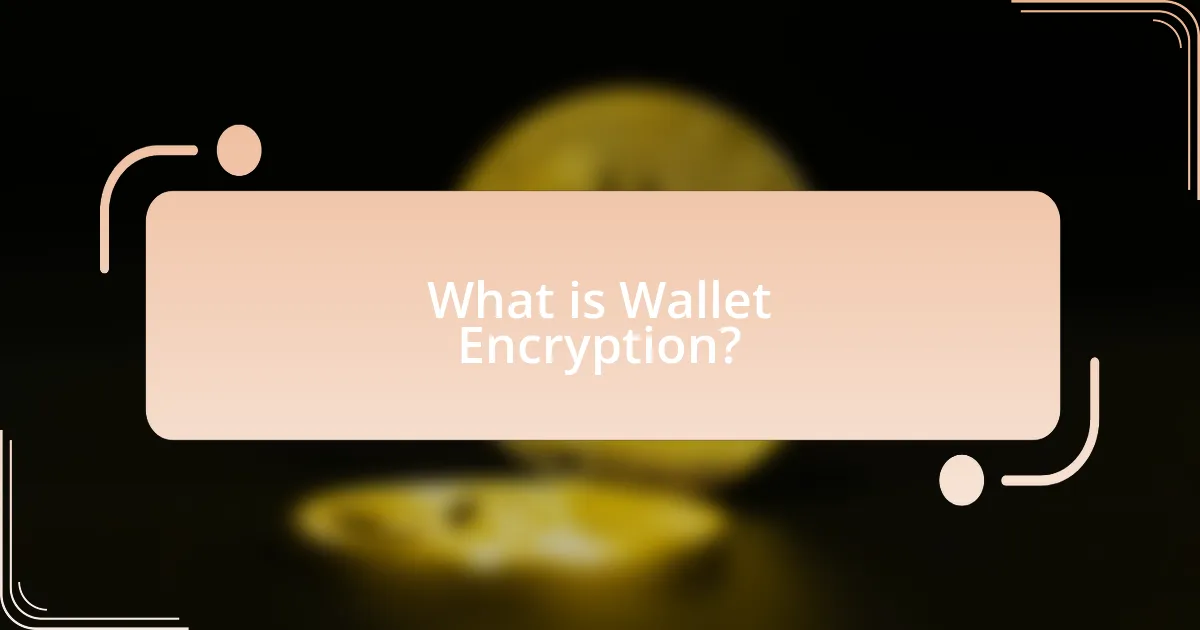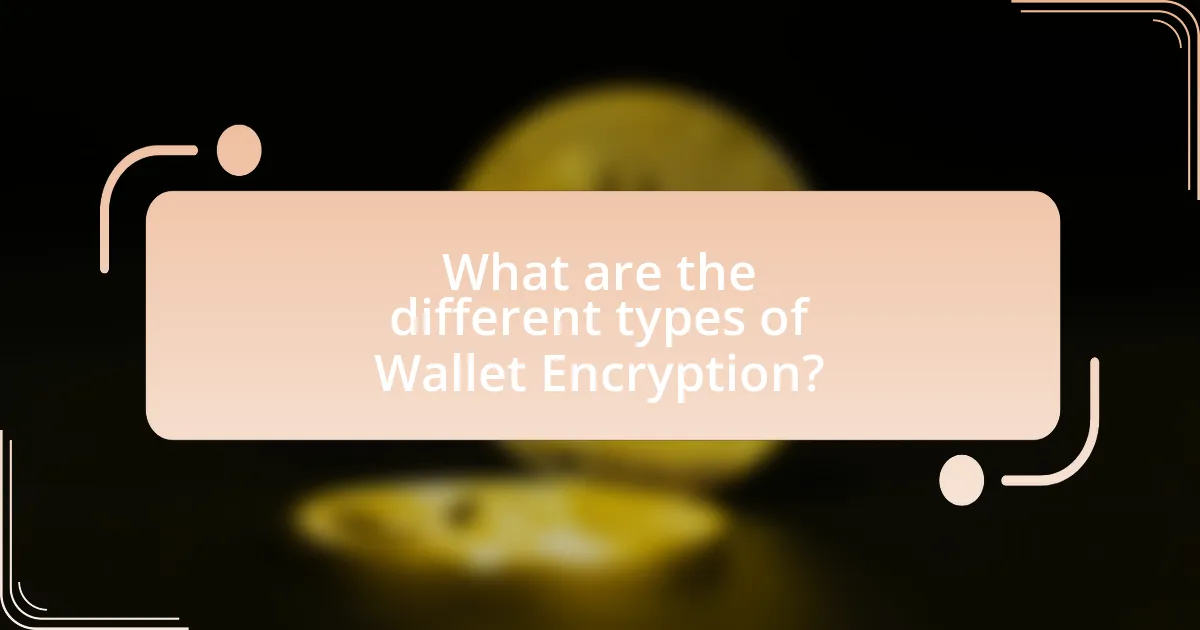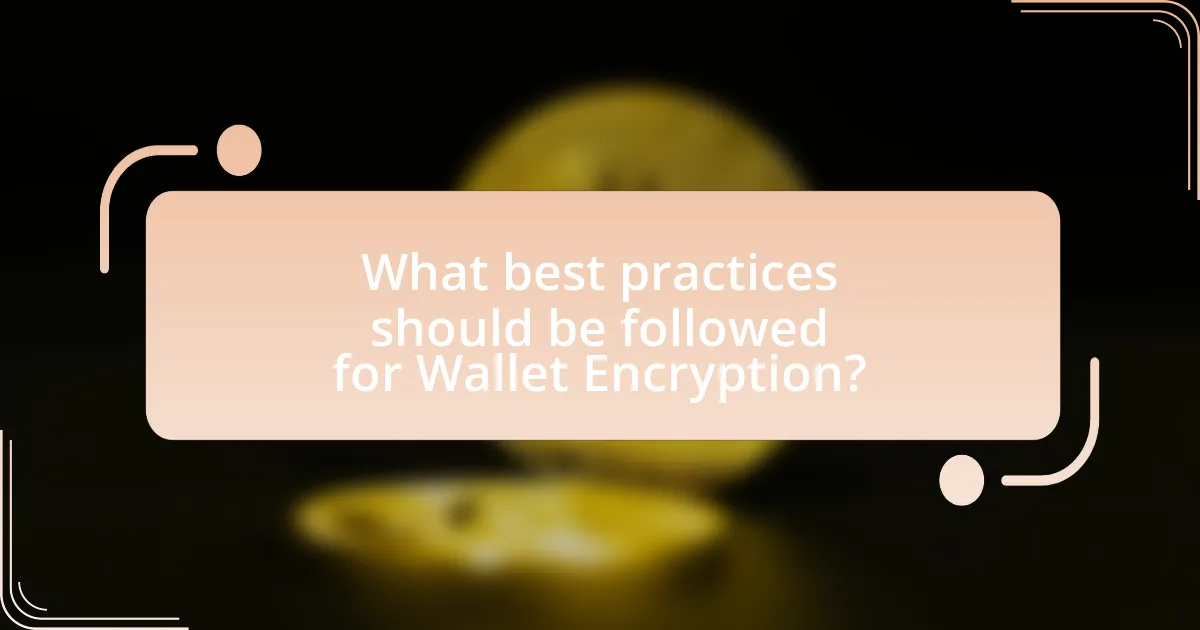Wallet encryption is a critical security measure designed to protect digital wallets by encoding sensitive data, making it accessible only to authorized users. The article explores how wallet encryption functions through cryptographic algorithms, the key components involved, and the importance of safeguarding private keys and transaction data from unauthorized access. It also discusses various types of wallet encryption, including symmetric and asymmetric methods, and highlights best practices for users to enhance their wallet security, such as using strong passwords and enabling two-factor authentication. Additionally, the article addresses emerging threats and future trends in wallet encryption technology, emphasizing the necessity of robust security measures in the evolving digital landscape.

What is Wallet Encryption?
Wallet encryption is a security measure that protects digital wallets by encoding the data stored within them, making it accessible only to authorized users. This process involves using cryptographic algorithms to transform the wallet’s contents into a format that cannot be easily read or manipulated without the correct decryption key or password. The significance of wallet encryption lies in its ability to safeguard sensitive information, such as private keys and transaction data, from unauthorized access and theft, thereby enhancing the overall security of digital assets.
How does Wallet Encryption work?
Wallet encryption works by securing digital wallets through cryptographic techniques that protect sensitive information, such as private keys and transaction data. This process typically involves the use of a password or passphrase that encrypts the wallet’s contents, making it accessible only to the user who possesses the correct credentials. The encryption algorithms, such as AES (Advanced Encryption Standard), ensure that even if unauthorized parties gain access to the wallet file, they cannot decipher the information without the decryption key. This method significantly enhances security by preventing theft and unauthorized transactions, as evidenced by the increasing adoption of wallet encryption in cryptocurrency platforms to safeguard user assets.
What are the key components of Wallet Encryption?
The key components of wallet encryption include encryption algorithms, secure key management, and user authentication. Encryption algorithms, such as AES (Advanced Encryption Standard), protect the wallet’s data by converting it into a secure format that is unreadable without the correct decryption key. Secure key management ensures that the private keys used for accessing the wallet are stored safely, often utilizing hardware security modules or secure enclaves to prevent unauthorized access. User authentication adds an additional layer of security, typically through passwords, biometric data, or two-factor authentication, ensuring that only authorized users can access the wallet. These components work together to safeguard digital assets against theft and unauthorized access.
How do these components ensure security?
Wallet encryption components ensure security by utilizing cryptographic algorithms to protect sensitive data. These algorithms, such as AES (Advanced Encryption Standard), encrypt wallet information, making it unreadable without the correct decryption key. Additionally, multi-factor authentication adds another layer of security by requiring multiple forms of verification before granting access to the wallet. This combination of encryption and authentication significantly reduces the risk of unauthorized access and data breaches, as evidenced by the fact that encrypted wallets are less likely to be compromised compared to unencrypted ones.
Why is Wallet Encryption important for security?
Wallet encryption is crucial for security because it protects sensitive financial information from unauthorized access. By encrypting a digital wallet, users ensure that their private keys and transaction data are encoded, making it significantly more difficult for hackers to steal or manipulate this information. According to a report by Cybersecurity Ventures, cybercrime is projected to cause damages exceeding $10.5 trillion annually by 2025, highlighting the increasing need for robust security measures like wallet encryption to safeguard against such threats.
What risks does Wallet Encryption mitigate?
Wallet encryption mitigates the risk of unauthorized access to digital assets. By encrypting a wallet, sensitive information such as private keys is transformed into a secure format that can only be accessed with the correct password or key. This process protects against theft, hacking, and loss of funds, as even if an attacker gains access to the wallet file, they cannot retrieve the private keys without the decryption key. Statistics indicate that a significant percentage of cryptocurrency thefts occur due to inadequate security measures, highlighting the importance of wallet encryption in safeguarding assets.
How does Wallet Encryption protect against unauthorized access?
Wallet encryption protects against unauthorized access by securing sensitive information with cryptographic algorithms that require a specific key or password for decryption. This means that even if an unauthorized user gains access to the wallet file, they cannot access the stored data without the correct decryption key. For instance, strong encryption methods like AES (Advanced Encryption Standard) are commonly used, which have been proven to be highly secure, making it extremely difficult for attackers to decrypt the data without the proper credentials.

What are the different types of Wallet Encryption?
The different types of wallet encryption include symmetric encryption, asymmetric encryption, and multi-signature encryption. Symmetric encryption uses a single key for both encryption and decryption, making it efficient but requiring secure key management. Asymmetric encryption employs a pair of keys—public and private—allowing for secure transactions without sharing sensitive information. Multi-signature encryption enhances security by requiring multiple private keys to authorize a transaction, reducing the risk of unauthorized access. Each type serves distinct security needs, ensuring the protection of digital assets in various scenarios.
How do software wallets utilize encryption?
Software wallets utilize encryption to secure private keys and transaction data, ensuring that sensitive information remains confidential and protected from unauthorized access. This encryption typically employs algorithms such as AES (Advanced Encryption Standard) to encode the data, making it unreadable without the correct decryption key. For instance, when a user creates a wallet, the software generates a unique encryption key that is used to encrypt the private keys stored within the wallet. This process safeguards against potential threats, such as hacking or malware, by rendering the data inaccessible to anyone who does not possess the decryption key.
What encryption methods are commonly used in software wallets?
Common encryption methods used in software wallets include AES (Advanced Encryption Standard), RSA (Rivest-Shamir-Adleman), and elliptic curve cryptography (ECC). AES is widely utilized for encrypting private keys due to its efficiency and strong security, often employing a 256-bit key length for enhanced protection. RSA is frequently used for secure key exchange, allowing users to encrypt data with a public key that can only be decrypted by the corresponding private key. ECC is favored for its ability to provide high security with smaller key sizes, making it efficient for mobile and resource-constrained environments. These methods collectively enhance the security of software wallets by protecting sensitive information from unauthorized access.
How does software wallet encryption differ from hardware wallet encryption?
Software wallet encryption relies on software-based security measures to protect private keys, while hardware wallet encryption utilizes dedicated physical devices to store keys securely. Software wallets are more vulnerable to malware and hacking since they operate on internet-connected devices, whereas hardware wallets are insulated from online threats, as they store keys offline. This distinction is critical; for instance, a 2020 report by the Cybersecurity and Infrastructure Security Agency noted that software wallets are often targeted by phishing attacks, while hardware wallets, due to their offline nature, provide a more robust defense against such threats.
What role does encryption play in hardware wallets?
Encryption is crucial in hardware wallets as it secures private keys and sensitive data from unauthorized access. By encrypting this information, hardware wallets ensure that even if the device is compromised, the encrypted data remains unreadable without the correct decryption key. This layer of security is vital because it protects users’ cryptocurrency assets from theft and hacking attempts, which are prevalent in the digital currency space. For instance, hardware wallets often utilize advanced encryption standards, such as AES-256, to safeguard data, making it significantly more difficult for attackers to access the stored information.
What are the advantages of hardware wallet encryption?
Hardware wallet encryption provides enhanced security for digital assets by safeguarding private keys from unauthorized access. This encryption ensures that even if the hardware wallet is compromised, the encrypted keys remain secure and inaccessible without the correct authentication. Additionally, hardware wallets often utilize secure elements that are resistant to physical tampering, further protecting against theft and fraud. According to a report by the European Union Agency for Cybersecurity, hardware wallets are considered one of the most secure methods for storing cryptocurrencies, as they keep sensitive information offline and away from potential online threats.
How does hardware wallet encryption enhance user security?
Hardware wallet encryption enhances user security by safeguarding private keys from unauthorized access and potential theft. This encryption ensures that sensitive information is stored in a secure environment, typically within a dedicated chip that is resistant to malware and hacking attempts. For instance, hardware wallets often utilize secure elements that comply with international standards, such as Common Criteria EAL5+, which provides a high level of assurance against physical and logical attacks. By keeping private keys offline and encrypted, hardware wallets significantly reduce the risk of exposure to online threats, thereby protecting users’ digital assets more effectively than software wallets.

What best practices should be followed for Wallet Encryption?
To ensure effective wallet encryption, users should implement strong, unique passwords and utilize two-factor authentication. Strong passwords should consist of at least 12 characters, including a mix of uppercase letters, lowercase letters, numbers, and special symbols, which significantly reduces the risk of unauthorized access. Two-factor authentication adds an additional layer of security by requiring a second form of verification, such as a text message or authentication app, making it harder for attackers to gain access even if they have the password. According to a study by the Cybersecurity & Infrastructure Security Agency, using multi-factor authentication can block 99.9% of automated attacks, highlighting its effectiveness in enhancing security.
How can users ensure their wallets are securely encrypted?
Users can ensure their wallets are securely encrypted by utilizing strong, unique passwords and enabling two-factor authentication. Strong passwords typically consist of at least 12 characters, including a mix of uppercase letters, lowercase letters, numbers, and special symbols, which significantly reduces the risk of unauthorized access. Two-factor authentication adds an additional layer of security by requiring a second form of verification, such as a code sent to a mobile device, making it more difficult for attackers to gain access even if they have the password. According to a study by the Cybersecurity & Infrastructure Security Agency, implementing these security measures can reduce the likelihood of successful cyberattacks by up to 99%.
What steps should be taken to create strong encryption passwords?
To create strong encryption passwords, use a combination of at least 12 characters, including uppercase letters, lowercase letters, numbers, and special symbols. This complexity significantly increases the difficulty of password cracking, as studies show that longer and more varied passwords are exponentially harder to guess or brute-force. Additionally, avoid using easily guessable information such as birthdays or common words, as these can be quickly compromised. Implementing a password manager can also help generate and store complex passwords securely, further enhancing your overall security.
How often should users update their encryption methods?
Users should update their encryption methods at least annually or whenever there is a significant change in their security environment. Regular updates are essential because encryption standards evolve, and vulnerabilities may be discovered over time. For instance, the National Institute of Standards and Technology (NIST) recommends reviewing cryptographic algorithms and protocols regularly to ensure they meet current security requirements. This proactive approach helps mitigate risks associated with outdated encryption practices.
What common mistakes should be avoided in Wallet Encryption?
Common mistakes to avoid in wallet encryption include using weak passwords, failing to enable two-factor authentication, and neglecting to keep software updated. Weak passwords can be easily cracked, compromising wallet security; studies show that 81% of data breaches are linked to weak passwords. Not enabling two-factor authentication increases vulnerability, as it adds an extra layer of security that can thwart unauthorized access. Additionally, outdated software may contain security flaws that hackers can exploit, making regular updates essential for maintaining robust wallet protection.
How can users prevent losing access to their encrypted wallets?
Users can prevent losing access to their encrypted wallets by securely backing up their private keys and recovery phrases. Regularly storing these critical pieces of information in multiple secure locations, such as a hardware wallet or a safe, ensures that users can regain access even if they lose their primary device. According to a study by the Cambridge Centre for Alternative Finance, 20% of Bitcoin is estimated to be lost due to users forgetting their private keys, highlighting the importance of proper backup practices.
What are the consequences of weak encryption practices?
Weak encryption practices lead to significant security vulnerabilities, allowing unauthorized access to sensitive data. When encryption is weak, attackers can easily exploit these weaknesses to decrypt information, resulting in data breaches, identity theft, and financial loss. For instance, the 2017 Equifax breach, which exposed the personal information of 147 million people, was partly attributed to inadequate encryption measures. Additionally, weak encryption can undermine user trust and lead to regulatory penalties, as organizations may fail to comply with data protection laws such as GDPR, which mandates strong encryption for personal data.
What are the future trends in Wallet Encryption?
Future trends in wallet encryption include the adoption of advanced cryptographic algorithms, integration of biometric authentication, and the use of decentralized technologies. Advanced cryptographic algorithms, such as post-quantum cryptography, are being developed to protect against potential threats posed by quantum computing, ensuring long-term security for digital wallets. Biometric authentication, including fingerprint and facial recognition, is increasingly being implemented to enhance user security and streamline access. Additionally, decentralized technologies, such as blockchain, are gaining traction as they provide increased transparency and security by eliminating single points of failure. These trends reflect the ongoing evolution of wallet encryption in response to emerging security challenges and user demands for enhanced protection.
How is technology evolving to enhance Wallet Encryption?
Technology is evolving to enhance wallet encryption through advancements in cryptographic algorithms, multi-factor authentication, and hardware security modules. Modern cryptographic algorithms, such as AES-256 and elliptic curve cryptography, provide stronger encryption standards that are more resistant to brute-force attacks. Multi-factor authentication adds an additional layer of security by requiring users to verify their identity through multiple methods, significantly reducing the risk of unauthorized access. Furthermore, hardware security modules, which store cryptographic keys in a secure environment, protect against software vulnerabilities and physical tampering. These developments collectively improve the security of digital wallets, ensuring that sensitive financial information remains protected against evolving cyber threats.
What emerging threats should users be aware of regarding Wallet Encryption?
Emerging threats regarding wallet encryption include advanced phishing attacks, malware targeting private keys, and vulnerabilities in wallet software. Phishing attacks have evolved to become more sophisticated, often mimicking legitimate services to deceive users into revealing their credentials. Malware, such as keyloggers or trojans, can infiltrate devices to capture private keys or passwords, compromising wallet security. Additionally, vulnerabilities in wallet software can be exploited by attackers, leading to unauthorized access and theft of funds. According to a report by the Cybersecurity and Infrastructure Security Agency (CISA), the rise in these threats underscores the importance of maintaining updated security practices and being vigilant against potential scams.
What practical tips can enhance your Wallet Encryption security?
To enhance your Wallet Encryption security, use strong, unique passwords and enable two-factor authentication (2FA). Strong passwords should be at least 12 characters long, combining letters, numbers, and symbols, which significantly reduces the risk of unauthorized access. Two-factor authentication adds an extra layer of security by requiring a second form of verification, such as a text message or authentication app, making it harder for attackers to gain access even if they have your password. According to a study by Google, enabling 2FA can block 100% of automated bots and 96% of phishing attacks, demonstrating its effectiveness in protecting sensitive information.